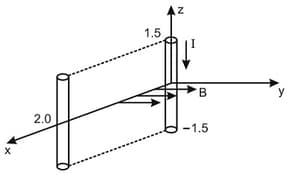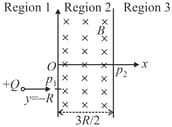The right-hand thumb rule is used to find the direction of magnetic field around a current carrying a straight conductor.
Important Questions on Magnetic Effects of Electric Current
A rectangular region of dimensions has a constant magnetic field into the plane of the paper as shown. On one side the region is bounded by a screen. On the other side positive ions of mass and charge are accelerated from rest and towards the screen by a parallel plate capacitor at constant potential difference , and come out through a small hole in the upper plate. Which one of the following statements is correct regarding the charge on the ions that hit the screen?
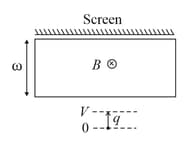
In a thin rectangular metallic strip a constant current I flows along the positive x - direction, as shown in the figure. The length, width and thickness of the strip are l, w and d, respectively. A uniform magnetic field is applied on the strip along positive y - direction. Due to this the charge carries experience a net deflection along the z-direction. This results in accumulation of charge carriers on the surface PQRS and appearance of equal opposite charges on the face opposite to PQRS. A potential difference along the z - direction is thus developed. Charge accumulation continues until the magnetic force is balanced by the electric force. The current is assumed to be uniformly distributed on the cross section of the strip and carried by electrons.

Consider two different metallic strips (1 and 2) of same dimensions (length , width and thickness ) with carrier densities and , respectively. Strip 1 is placed in magnetic field and strip 2 is placed in magnetic field , both along positive -directions. Then and are the potential differences developed between and in strips 1 and 2 respectively. Assuming that the current is the same for both strips, the correct option(s) is (are)
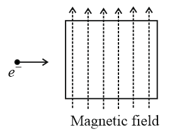
During its motion inside the chamber

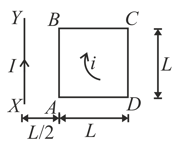

Let and be the magnitude of the force between the two wires in setup and setup , respectively.
In a thin rectangular metallic strip a constant current I flows along the positive x - direction, as shown in the figure. The length, width and thickness of the strip are l, w and d, respectively. A uniform magnetic field is applied on the strip along positive y - direction. Due to this the charge carries experience a net deflection along the z-direction. This results in accumulation of charge carriers on the surface PQRS and appearance of equal opposite charges on the face opposite to PQRS. A potential difference along the z - direction is thus developed. Charge accumulation continues until the magnetic force is balanced by the electric force. The current is assumed to be uniformly distributed on the cross section of the strip and carried by electrons.

Consider two different metallic strips (1 and 2) of the same material. Their lengths are the same, widths are and and thicknesses are and , respectively. Two points and are symmetrically located on the opposite faces parallel to the - plane (see figure). and are the potential differences between and in strips 1 and 2 respectively. Then, for a given current flowing through them in a given magnetic field strength , the correct statement(s) is (are)
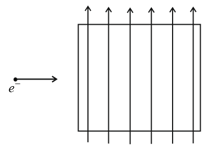
An electric field of appropriate magnitude is also applied so that the electron travels un-deviated without any change in its speed through the chamber. We are ignoring gravity. Then, the direction of the electric field is,
